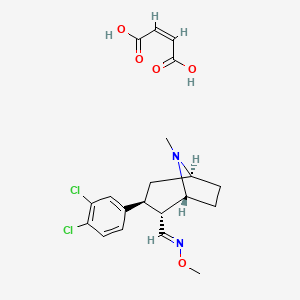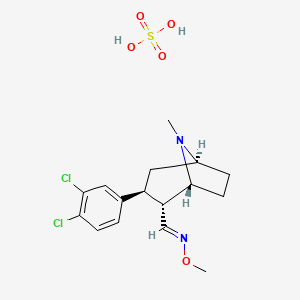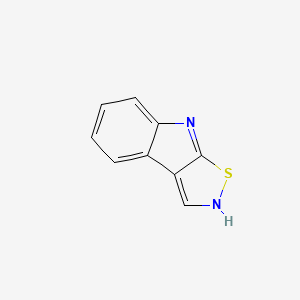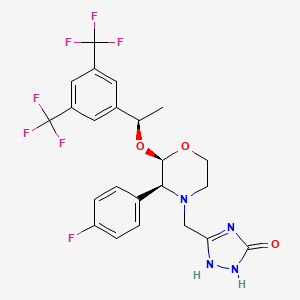
Aprepitant
Übersicht
Beschreibung
Aprepitant ist ein Medikament, das in erster Linie zur Vorbeugung von Chemotherapie-induzierter Übelkeit und Erbrechen sowie von postoperativem Erbrechen eingesetzt wird . Es gehört zur Klasse der Neurokinin-1-Rezeptor-Antagonisten und wirkt, indem es die Wirkung von Substanz P, einem Neuropeptid, das mit Erbrechen assoziiert ist, blockiert . This compound wird unter dem Markennamen Emend vermarktet, unter anderem .
Wissenschaftliche Forschungsanwendungen
Aprepitant hat eine breite Palette von Anwendungen in der wissenschaftlichen Forschung, insbesondere in den Bereichen Chemie, Biologie, Medizin und Industrie . In der Chemie wird es als Modellverbindung für die Untersuchung der Synthese und Charakterisierung von Neurokinin-1-Rezeptor-Antagonisten verwendet . In der Biologie wird this compound verwendet, um die Rolle von Substanz P in verschiedenen physiologischen und pathologischen Prozessen zu untersuchen . In der Medizin wird es häufig verwendet, um Übelkeit und Erbrechen bei Patienten zu verhindern, die sich einer Chemotherapie oder Operation unterziehen . Darüber hinaus wird this compound für seinen potenziellen Einsatz bei der Behandlung anderer Erkrankungen wie Depression und Angststörungen untersucht .
Wirkmechanismus
This compound übt seine Wirkungen aus, indem es selektiv die Neurokinin-1 (NK1)-Rezeptoren im Gehirn blockiert . Diese Rezeptoren werden durch Substanz P aktiviert, ein Neuropeptid, das am Brechreflex beteiligt ist . Durch die Hemmung der Bindung von Substanz P an NK1-Rezeptoren verhindert this compound effektiv die Übertragung von Signalen, die Übelkeit und Erbrechen auslösen . Dieser Wirkmechanismus macht this compound zu einer wertvollen Zusatztherapie in Kombination mit anderen Antiemetika, wie Serotonin (5-HT3)-Rezeptor-Antagonisten und Kortikosteroiden .
Wirkmechanismus
Target of Action
Aprepitant is a selective high-affinity antagonist of human substance P/neurokinin 1 (NK1) receptors . It has little or no affinity for serotonin (5-HT3), dopamine, and corticosteroid receptors .
Mode of Action
this compound works by blocking the action of a natural substance in the brain called neurokinin . It has been shown in animal models to inhibit emesis induced by cytotoxic chemotherapeutic agents, such as cisplatin, via central actions . Positron Emission Tomography (PET) studies with this compound have shown that it crosses the blood-brain barrier and occupies brain NK1 receptors .
Biochemical Pathways
this compound primarily undergoes CYP3A4-mediated metabolism, with minor metabolism mediated by CYP1A2 and CYP2C19 . About seven metabolites of this compound have been identified in human plasma, all of which retain weak pharmacological activity . In addition to being a substrate, this compound has been shown to moderately inhibit CYP3A4 and mildly induce CYP2C9 .
Pharmacokinetics
this compound has a bioavailability of 60–65% . It is highly protein-bound (>95%) and is metabolized in the liver, mostly by CYP3A4, with some contributions by CYP2C19 and CYP1A2 . The elimination half-life of this compound is 9–13 hours, and it is excreted via the kidneys (57%) and feces (45%) .
Result of Action
this compound has been shown to have multiple antitumor actions against many types of cancer . It significantly inhibits the excitability of Dorsal Root Ganglion (DRG) neurons . The pain behavior and the paw tissues inflammatory damage were significantly relieved after the administration of this compound . This compound significantly suppressed the activation of microglia, phosphorylation of JNK and p38 MAPK, as well as the mRNA and protein expressions of MCP-1, TNF-α, IL-6, and IL-1β, in vivo and in vitro .
Action Environment
Environmental factors can influence the action of this compound. For example, in cancer cells, this compound increases the sensitization of these cells to the cytotoxic action of certain substances . It impairs the interaction of Forkhead box M1 with beta-catenin, leading to the blockade of the Wnt canonical pathway . It arrests the G2 cell cycle, promoting apoptosis .
Biochemische Analyse
Biochemical Properties
Aprepitant interacts with the NK1 receptors, blocking the signals given off by these receptors . It has little or no affinity for serotonin (5-HT3), dopamine, and corticosteroid receptors .
Cellular Effects
This compound has been shown to inhibit the proliferation, migration, and invasion of gallbladder cancer cells . It also significantly boosts the apoptosis, reactive oxygen species (ROS), and inflammation response in gallbladder cancer .
Molecular Mechanism
This compound works by blocking substance P from attaching to the NK1 receptors . This decreases the likelihood of vomiting in patients . It is classified as an NK1 antagonist because it blocks signals given off by NK1 receptors .
Temporal Effects in Laboratory Settings
This compound provides protection against nausea and vomiting over multiple cycles of cisplatin-based chemotherapy . It has been shown to enhance control of chemotherapy-induced nausea and vomiting (CINV) over time .
Dosage Effects in Animal Models
In animal models, this compound has been shown to have anti-inflammatory and antioxidant properties . The effects of this compound on the lung tissues of rats with an experimental polymicrobial sepsis model were examined, and it was found that this compound effectively inhibited the proliferation, migration, and invasion of these cells .
Metabolic Pathways
This compound primarily undergoes CYP3A4-mediated metabolism, as well as minor metabolism mediated by CYP1A2 and CYP2C19 . About seven metabolites of this compound have been identified in human plasma, which all retain weak pharmacological activity .
Transport and Distribution
This compound is generally safe and well tolerated in healthy subjects. Its pharmacokinetics is comparable between different ethnicities following single-dose administration . The pharmacokinetics following a clinical 3-day regimen on healthy subjects has been characterized .
Vorbereitungsmethoden
Synthesewege und Reaktionsbedingungen: Aprepitant wird durch einen mehrstufigen Prozess synthetisiert, der mehrere wichtige Zwischenprodukte umfasst. Die Synthese beginnt typischerweise mit der Herstellung eines Morpholin-Derivats, das dann verschiedenen chemischen Reaktionen unterzogen wird, darunter Alkylierung, Acylierung und Cyclisierung . Das Endprodukt wird durch Reinigungs- und Kristallisationsschritte gewonnen, um eine hohe Reinheit und Ausbeute zu gewährleisten .
Industrielle Produktionsverfahren: In industriellen Umgebungen beinhaltet die Produktion von this compound die Optimierung der Reaktionsbedingungen, um die Ausbeute zu maximieren und Verunreinigungen zu minimieren. Techniken wie Hochleistungsflüssigchromatographie (HPLC) und Gaschromatographie (GC) werden verwendet, um den Reaktionsfortschritt zu überwachen und die Qualität des Endprodukts sicherzustellen . Darüber hinaus werden fortschrittliche Formulierungstechniken wie Nanopräzipitation und feste Dispersion eingesetzt, um die Löslichkeit und Bioverfügbarkeit von this compound zu verbessern .
Analyse Chemischer Reaktionen
Reaktionstypen: Aprepitant unterliegt verschiedenen chemischen Reaktionen, darunter Oxidation, Reduktion und Substitution . Diese Reaktionen sind unerlässlich, um die chemische Struktur zu modifizieren und die pharmakologischen Eigenschaften der Verbindung zu verbessern.
Häufige Reagenzien und Bedingungen: Häufige Reagenzien, die bei der Synthese von this compound verwendet werden, sind Alkylierungsmittel, Acylierungsmittel und Reduktionsmittel . Die Reaktionen werden typischerweise unter kontrollierten Bedingungen durchgeführt, wie z. B. bestimmten Temperaturen, Drücken und pH-Werten, um optimale Ausbeuten und minimale Nebenreaktionen zu gewährleisten .
Hauptprodukte, die gebildet werden: Die Hauptprodukte, die aus den chemischen Reaktionen von this compound gebildet werden, umfassen seine verschiedenen Zwischenprodukte und den endgültigen pharmazeutischen Wirkstoff (API) . Diese Produkte werden mit Techniken wie Kernresonanzspektroskopie (NMR), Massenspektrometrie (MS) und Infrarotspektroskopie (IR) charakterisiert, um ihre Strukturen und Reinheiten zu bestätigen .
Vergleich Mit ähnlichen Verbindungen
Aprepitant wird oft mit anderen Antiemetika wie Ondansetron und Dexamethason verglichen . Während Ondansetron ein Serotonin (5-HT3)-Rezeptor-Antagonist und Dexamethason ein Kortikosteroid ist, ist this compound in seinem Wirkmechanismus als NK1-Rezeptor-Antagonist einzigartig . Dieser besondere Mechanismus ermöglicht es this compound, traditionelle Antiemetika zu ergänzen und die Kontrolle von Chemotherapie-induzierter Übelkeit und Erbrechen zu verbessern . Andere ähnliche Verbindungen sind Fosthis compound, ein Prodrug von this compound, das im Körper zu this compound umgewandelt wird und den gleichen Wirkmechanismus aufweist .
Eigenschaften
IUPAC Name |
3-[[(2R,3S)-2-[(1R)-1-[3,5-bis(trifluoromethyl)phenyl]ethoxy]-3-(4-fluorophenyl)morpholin-4-yl]methyl]-1,4-dihydro-1,2,4-triazol-5-one | |
|---|---|---|
| Source | PubChem | |
| URL | https://pubchem.ncbi.nlm.nih.gov | |
| Description | Data deposited in or computed by PubChem | |
InChI |
InChI=1S/C23H21F7N4O3/c1-12(14-8-15(22(25,26)27)10-16(9-14)23(28,29)30)37-20-19(13-2-4-17(24)5-3-13)34(6-7-36-20)11-18-31-21(35)33-32-18/h2-5,8-10,12,19-20H,6-7,11H2,1H3,(H2,31,32,33,35)/t12-,19+,20-/m1/s1 | |
| Source | PubChem | |
| URL | https://pubchem.ncbi.nlm.nih.gov | |
| Description | Data deposited in or computed by PubChem | |
InChI Key |
ATALOFNDEOCMKK-OITMNORJSA-N | |
| Source | PubChem | |
| URL | https://pubchem.ncbi.nlm.nih.gov | |
| Description | Data deposited in or computed by PubChem | |
Canonical SMILES |
CC(C1=CC(=CC(=C1)C(F)(F)F)C(F)(F)F)OC2C(N(CCO2)CC3=NNC(=O)N3)C4=CC=C(C=C4)F | |
| Source | PubChem | |
| URL | https://pubchem.ncbi.nlm.nih.gov | |
| Description | Data deposited in or computed by PubChem | |
Isomeric SMILES |
C[C@H](C1=CC(=CC(=C1)C(F)(F)F)C(F)(F)F)O[C@@H]2[C@@H](N(CCO2)CC3=NNC(=O)N3)C4=CC=C(C=C4)F | |
| Source | PubChem | |
| URL | https://pubchem.ncbi.nlm.nih.gov | |
| Description | Data deposited in or computed by PubChem | |
Molecular Formula |
C23H21F7N4O3 | |
| Source | PubChem | |
| URL | https://pubchem.ncbi.nlm.nih.gov | |
| Description | Data deposited in or computed by PubChem | |
DSSTOX Substance ID |
DTXSID3049047 | |
| Record name | Aprepitant | |
| Source | EPA DSSTox | |
| URL | https://comptox.epa.gov/dashboard/DTXSID3049047 | |
| Description | DSSTox provides a high quality public chemistry resource for supporting improved predictive toxicology. | |
Molecular Weight |
534.4 g/mol | |
| Source | PubChem | |
| URL | https://pubchem.ncbi.nlm.nih.gov | |
| Description | Data deposited in or computed by PubChem | |
Physical Description |
Solid | |
| Record name | Aprepitant | |
| Source | Human Metabolome Database (HMDB) | |
| URL | http://www.hmdb.ca/metabolites/HMDB0014811 | |
| Description | The Human Metabolome Database (HMDB) is a freely available electronic database containing detailed information about small molecule metabolites found in the human body. | |
| Explanation | HMDB is offered to the public as a freely available resource. Use and re-distribution of the data, in whole or in part, for commercial purposes requires explicit permission of the authors and explicit acknowledgment of the source material (HMDB) and the original publication (see the HMDB citing page). We ask that users who download significant portions of the database cite the HMDB paper in any resulting publications. | |
Solubility |
Practically insoluble, 1.94e-02 g/L | |
| Record name | Aprepitant | |
| Source | DrugBank | |
| URL | https://www.drugbank.ca/drugs/DB00673 | |
| Description | The DrugBank database is a unique bioinformatics and cheminformatics resource that combines detailed drug (i.e. chemical, pharmacological and pharmaceutical) data with comprehensive drug target (i.e. sequence, structure, and pathway) information. | |
| Explanation | Creative Common's Attribution-NonCommercial 4.0 International License (http://creativecommons.org/licenses/by-nc/4.0/legalcode) | |
| Record name | Aprepitant | |
| Source | Human Metabolome Database (HMDB) | |
| URL | http://www.hmdb.ca/metabolites/HMDB0014811 | |
| Description | The Human Metabolome Database (HMDB) is a freely available electronic database containing detailed information about small molecule metabolites found in the human body. | |
| Explanation | HMDB is offered to the public as a freely available resource. Use and re-distribution of the data, in whole or in part, for commercial purposes requires explicit permission of the authors and explicit acknowledgment of the source material (HMDB) and the original publication (see the HMDB citing page). We ask that users who download significant portions of the database cite the HMDB paper in any resulting publications. | |
Mechanism of Action |
Aprepitant has been shown in animal models to inhibit emesis induced by cytotoxic chemotherapeutic agents, such as cisplatin, via central actions. Animal and human Positron Emission Tomography (PET) studies with Aprepitant have shown that it crosses the blood brain barrier and occupies brain NK1 receptors. Animal and human studies show that Aprepitant augments the antiemetic activity of the 5-HT3-receptor antagonist ondansetron and the corticosteroid ethasone and inhibits both the acute and delayed phases of cisplatin induced emesis. | |
| Record name | Aprepitant | |
| Source | DrugBank | |
| URL | https://www.drugbank.ca/drugs/DB00673 | |
| Description | The DrugBank database is a unique bioinformatics and cheminformatics resource that combines detailed drug (i.e. chemical, pharmacological and pharmaceutical) data with comprehensive drug target (i.e. sequence, structure, and pathway) information. | |
| Explanation | Creative Common's Attribution-NonCommercial 4.0 International License (http://creativecommons.org/licenses/by-nc/4.0/legalcode) | |
CAS No. |
170729-80-3 | |
| Record name | Aprepitant | |
| Source | CAS Common Chemistry | |
| URL | https://commonchemistry.cas.org/detail?cas_rn=170729-80-3 | |
| Description | CAS Common Chemistry is an open community resource for accessing chemical information. Nearly 500,000 chemical substances from CAS REGISTRY cover areas of community interest, including common and frequently regulated chemicals, and those relevant to high school and undergraduate chemistry classes. This chemical information, curated by our expert scientists, is provided in alignment with our mission as a division of the American Chemical Society. | |
| Explanation | The data from CAS Common Chemistry is provided under a CC-BY-NC 4.0 license, unless otherwise stated. | |
| Record name | Aprepitant [USAN:INN:JAN] | |
| Source | ChemIDplus | |
| URL | https://pubchem.ncbi.nlm.nih.gov/substance/?source=chemidplus&sourceid=0170729803 | |
| Description | ChemIDplus is a free, web search system that provides access to the structure and nomenclature authority files used for the identification of chemical substances cited in National Library of Medicine (NLM) databases, including the TOXNET system. | |
| Record name | Aprepitant | |
| Source | DrugBank | |
| URL | https://www.drugbank.ca/drugs/DB00673 | |
| Description | The DrugBank database is a unique bioinformatics and cheminformatics resource that combines detailed drug (i.e. chemical, pharmacological and pharmaceutical) data with comprehensive drug target (i.e. sequence, structure, and pathway) information. | |
| Explanation | Creative Common's Attribution-NonCommercial 4.0 International License (http://creativecommons.org/licenses/by-nc/4.0/legalcode) | |
| Record name | Aprepitant | |
| Source | DTP/NCI | |
| URL | https://dtp.cancer.gov/dtpstandard/servlet/dwindex?searchtype=NSC&outputformat=html&searchlist=748825 | |
| Description | The NCI Development Therapeutics Program (DTP) provides services and resources to the academic and private-sector research communities worldwide to facilitate the discovery and development of new cancer therapeutic agents. | |
| Explanation | Unless otherwise indicated, all text within NCI products is free of copyright and may be reused without our permission. Credit the National Cancer Institute as the source. | |
| Record name | Aprepitant | |
| Source | EPA DSSTox | |
| URL | https://comptox.epa.gov/dashboard/DTXSID3049047 | |
| Description | DSSTox provides a high quality public chemistry resource for supporting improved predictive toxicology. | |
| Record name | Aprepitant | |
| Source | European Chemicals Agency (ECHA) | |
| URL | https://echa.europa.eu/information-on-chemicals | |
| Description | The European Chemicals Agency (ECHA) is an agency of the European Union which is the driving force among regulatory authorities in implementing the EU's groundbreaking chemicals legislation for the benefit of human health and the environment as well as for innovation and competitiveness. | |
| Explanation | Use of the information, documents and data from the ECHA website is subject to the terms and conditions of this Legal Notice, and subject to other binding limitations provided for under applicable law, the information, documents and data made available on the ECHA website may be reproduced, distributed and/or used, totally or in part, for non-commercial purposes provided that ECHA is acknowledged as the source: "Source: European Chemicals Agency, http://echa.europa.eu/". Such acknowledgement must be included in each copy of the material. ECHA permits and encourages organisations and individuals to create links to the ECHA website under the following cumulative conditions: Links can only be made to webpages that provide a link to the Legal Notice page. | |
| Record name | APREPITANT | |
| Source | FDA Global Substance Registration System (GSRS) | |
| URL | https://gsrs.ncats.nih.gov/ginas/app/beta/substances/1NF15YR6UY | |
| Description | The FDA Global Substance Registration System (GSRS) enables the efficient and accurate exchange of information on what substances are in regulated products. Instead of relying on names, which vary across regulatory domains, countries, and regions, the GSRS knowledge base makes it possible for substances to be defined by standardized, scientific descriptions. | |
| Explanation | Unless otherwise noted, the contents of the FDA website (www.fda.gov), both text and graphics, are not copyrighted. They are in the public domain and may be republished, reprinted and otherwise used freely by anyone without the need to obtain permission from FDA. Credit to the U.S. Food and Drug Administration as the source is appreciated but not required. | |
| Record name | Aprepitant | |
| Source | Human Metabolome Database (HMDB) | |
| URL | http://www.hmdb.ca/metabolites/HMDB0014811 | |
| Description | The Human Metabolome Database (HMDB) is a freely available electronic database containing detailed information about small molecule metabolites found in the human body. | |
| Explanation | HMDB is offered to the public as a freely available resource. Use and re-distribution of the data, in whole or in part, for commercial purposes requires explicit permission of the authors and explicit acknowledgment of the source material (HMDB) and the original publication (see the HMDB citing page). We ask that users who download significant portions of the database cite the HMDB paper in any resulting publications. | |
Retrosynthesis Analysis
AI-Powered Synthesis Planning: Our tool employs the Template_relevance Pistachio, Template_relevance Bkms_metabolic, Template_relevance Pistachio_ringbreaker, Template_relevance Reaxys, Template_relevance Reaxys_biocatalysis model, leveraging a vast database of chemical reactions to predict feasible synthetic routes.
One-Step Synthesis Focus: Specifically designed for one-step synthesis, it provides concise and direct routes for your target compounds, streamlining the synthesis process.
Accurate Predictions: Utilizing the extensive PISTACHIO, BKMS_METABOLIC, PISTACHIO_RINGBREAKER, REAXYS, REAXYS_BIOCATALYSIS database, our tool offers high-accuracy predictions, reflecting the latest in chemical research and data.
Strategy Settings
| Precursor scoring | Relevance Heuristic |
|---|---|
| Min. plausibility | 0.01 |
| Model | Template_relevance |
| Template Set | Pistachio/Bkms_metabolic/Pistachio_ringbreaker/Reaxys/Reaxys_biocatalysis |
| Top-N result to add to graph | 6 |
Feasible Synthetic Routes
Q1: What is the primary mechanism of action of aprepitant?
A1: this compound exerts its antiemetic effect by acting as a selective antagonist of the neurokinin-1 (NK-1) receptor. [, , , , ] This receptor, primarily located in the central nervous system (CNS), is the primary binding site for substance P, a neuropeptide involved in the transmission of nausea and vomiting signals. [, , ] By blocking substance P from binding to NK-1 receptors, this compound effectively disrupts the emetic pathway. []
Q2: What makes this compound particularly effective against delayed CINV?
A2: this compound demonstrates prolonged NK-1 receptor occupancy in the CNS, lasting at least 48 hours after a single dose of its prodrug fosthis compound. [, ] This sustained receptor blockade effectively controls delayed CINV, which typically manifests 2 to 5 days post-chemotherapy. []
Q3: Does this compound affect gastric emptying?
A3: While this compound effectively controls nausea, there is evidence suggesting that it does not significantly accelerate gastric emptying. [] This suggests its antiemetic action is primarily mediated through central NK-1 receptor antagonism rather than by directly influencing gastric motility.
Q4: What is the molecular formula and weight of this compound?
A4: Unfortunately, the provided research papers do not explicitly state the molecular formula and weight of this compound. For detailed structural information, it is recommended to consult additional resources like PubChem or DrugBank databases.
Q5: What is fosthis compound, and how does it relate to this compound?
A5: Fosthis compound is a water-soluble prodrug of this compound, meaning it is converted into active this compound in the body. [, , , , , ] It is administered intravenously and rapidly metabolized into this compound via ubiquitous phosphatases within 30 minutes of administration. [, ] This makes it a suitable alternative for patients who have difficulty tolerating oral medications. [, , ]
Q6: How is this compound metabolized?
A6: this compound undergoes extensive metabolism, primarily by cytochrome P450 (CYP) 3A4 enzymes. [, , , , ] It is first metabolized into the active N-dealkylated metabolite (ND-AP), which is further converted into its carbonyl form (ND-CAP). []
Q7: Does food intake influence the bioavailability of this compound?
A7: Studies indicate that food does not significantly impact the bioavailability of a single oral dose of this compound, suggesting dose adjustments based on food intake are unnecessary. []
Q8: What is the relationship between this compound exposure and total bilirubin levels?
A8: A study investigating this compound pharmacokinetics in cancer patients revealed a significant correlation between the 120-hour area under the curve (AUC) of this compound and total bilirubin levels. [] This suggests that liver function may influence this compound exposure, but further investigation is needed to fully elucidate this relationship.
Q9: What are the approved clinical applications of this compound and fosthis compound?
A9: Both this compound and fosthis compound are FDA-approved for preventing CINV in patients undergoing highly emetogenic chemotherapy, typically in combination with a corticosteroid (like dexamethasone) and a 5-HT3 receptor antagonist (like ondansetron). [, , , , , , , ]
Q10: Can a single dose of fosthis compound effectively prevent CINV?
A10: Yes, clinical trials have demonstrated that a single intravenous dose of fosthis compound (150 mg) is noninferior to the standard 3-day this compound regimen for preventing both acute and delayed CINV in patients receiving high-dose cisplatin. [, , ]
Q11: Is this compound effective in preventing CINV in pediatric patients?
A11: While further research is necessary, studies suggest that this compound, in combination with standard antiemetic therapy, can be effective in reducing CINV in children and adolescents. [, , , ] One study even reported the safe use of this compound in children as young as 11 months old. []
Q12: Are there alternative antiemetic regimens to this compound for CINV?
A12: A fixed-dose combination of netupitant (another NK-1 receptor antagonist) and palonosetron (a 5-HT3 receptor antagonist), known as NEPA, has shown comparable efficacy to a 3-day this compound regimen in preventing CINV associated with moderately emetogenic chemotherapy. []
Q13: Does this compound interact with other medications?
A13: Yes, this compound is metabolized by CYP3A4 and can both inhibit and induce this enzyme, potentially leading to drug interactions. [, , , , ] For instance, this compound can increase the plasma concentrations of dexamethasone and methylprednisolone. [, , ] It can also decrease the plasma concentrations of drugs metabolized by CYP3A4, such as warfarin and hormonal contraceptives. [, , ]
Q14: Does this compound interact with vincristine?
A14: While this compound does not appear to cause a clinically significant drug interaction with vincristine that leads to early-onset peripheral neuropathy, there seems to be an increased risk of overall chemotherapy-induced peripheral neuropathy (CIPN) with concomitant use. [] Further research is needed to fully understand this potential interaction.
Q15: Does this compound affect prednisolone pharmacokinetics?
A15: A study investigating the co-administration of this compound with the R-CHOP chemotherapy regimen, which includes prednisolone, found no significant impact of this compound on prednisolone pharmacokinetics. [] This is consistent with previous findings that CYP3A4 inhibitors, like ketoconazole and itraconazole, do not affect prednisolone metabolism, unlike their effect on dexamethasone and methylprednisolone. []
Q16: How does this compound interact with voriconazole?
A16: this compound initially inhibits voriconazole metabolism due to its triazole ring, but subsequently induces CYP3A4, leading to increased voriconazole metabolism and potentially subtherapeutic drug levels. [] This interaction highlights the importance of monitoring voriconazole levels when co-administered with this compound or fosthis compound.
Q17: Are there any potential antitumor effects of this compound?
A17: While currently used as an antiemetic, preclinical studies suggest that this compound may possess antitumor properties through various mechanisms, including antiproliferative, antimetastatic, and pro-apoptotic effects. [, ] Further research is warranted to explore these findings and assess the potential of repurposing this compound as an anticancer agent.
Q18: Does this compound have any immunomodulatory effects?
A18: Research suggests that this compound may possess immunomodulatory properties by decreasing the expression of programmed death 1 (PD-1) on CD4+ T cells and reducing plasma levels of substance P and soluble CD163. [] This indicates a potential role of NK-1 receptor antagonism in modulating monocyte activation during HIV infection, warranting further investigation.
Haftungsausschluss und Informationen zu In-Vitro-Forschungsprodukten
Bitte beachten Sie, dass alle Artikel und Produktinformationen, die auf BenchChem präsentiert werden, ausschließlich zu Informationszwecken bestimmt sind. Die auf BenchChem zum Kauf angebotenen Produkte sind speziell für In-vitro-Studien konzipiert, die außerhalb lebender Organismen durchgeführt werden. In-vitro-Studien, abgeleitet von dem lateinischen Begriff "in Glas", beinhalten Experimente, die in kontrollierten Laborumgebungen unter Verwendung von Zellen oder Geweben durchgeführt werden. Es ist wichtig zu beachten, dass diese Produkte nicht als Arzneimittel oder Medikamente eingestuft sind und keine Zulassung der FDA für die Vorbeugung, Behandlung oder Heilung von medizinischen Zuständen, Beschwerden oder Krankheiten erhalten haben. Wir müssen betonen, dass jede Form der körperlichen Einführung dieser Produkte in Menschen oder Tiere gesetzlich strikt untersagt ist. Es ist unerlässlich, sich an diese Richtlinien zu halten, um die Einhaltung rechtlicher und ethischer Standards in Forschung und Experiment zu gewährleisten.


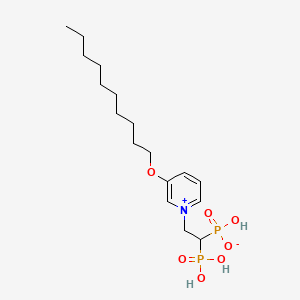
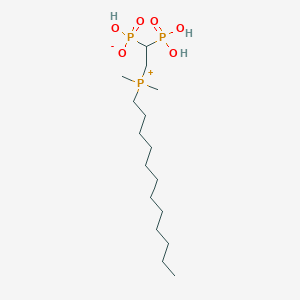

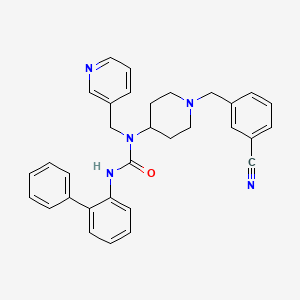

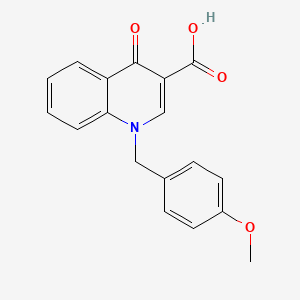
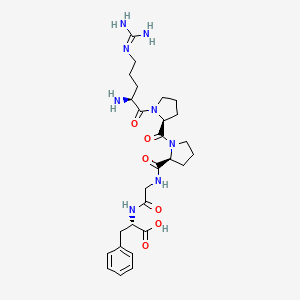
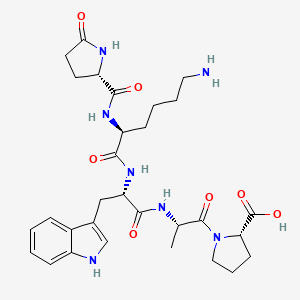
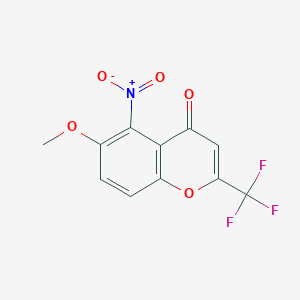
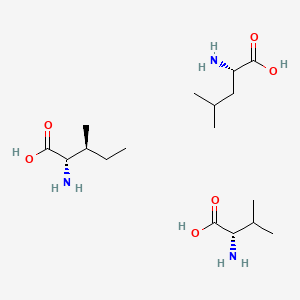
![(E)-1-[(2R,3S)-3-(3,4-Dichlorophenyl)-8-methyl-8-azabicyclo[3.2.1]octan-2-yl]-N-methoxymethanimine](/img/structure/B1667503.png)
